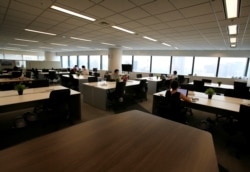Hybrid schedules could be the next monumental shift in the American workplace after last year's sudden move to remote work.
More than 70% of workers want to hold onto flexible remote work options, according to a Microsoft study, but almost as many — about 65% — still want more in-person time with their coworkers.
A hybrid schedule — where people are in the office some of the time while working at home for the rest — could meet both of those needs.
Companies increasingly seem to be getting onboard with hybrid scheduling now that the pandemic has demonstrated that working from home can be productive. The study found that remote job postings on the professional networking site LinkedIn increased drastically — more than five times — during the pandemic.
“If some companies are offering (remote work), then it's going to force the hand of other companies,” says Cathleen Swody, an organizational psychologist at Thrive Leadership. “So, if they want talent, they're going to have to have a little bit more flexibility. And along with all the flexibility, it's the processes — who's doing what? Who really needs to be in the office? Who needs that collaboration? Who doesn't? And rethinking how the work is done.”
General Motors recently announced that its 155,000 employees worldwide would be able to choose between working from home or being in the office, depending on what project they’re working on. JPMorgan Chase has hybrid plans that could mean the company only needs room in the office for 60 out of every 100 employees.
But a hybrid setup has its challenges. Fifty-four percent of people who’ve worked from home this past year feel overworked, and 39% say they’re downright exhausted.
Kristen Carpenter, chief psychologist in the Department of Psychiatry and Behavioral Health at The Ohio State University Wexner Medical Center, says clear parameters set by the employer will be key in any hybrid work situation.
“At-home work, the remote work — you've got a lot more activity outside of business hours, on the weekends, and that kind of digital burden is important to keep in mind. I think when people shift to a remote work or a work-from-home model, it's easy to not draw that boundary and to have work be ever-present,” she says. “Being mindful of digital overload, the ways in which work encroaches upon people's home lives will be really important.”
Younger workers are struggling more when it comes to feeling engaged or excited about work while working from home, according to the study. And there are concerns that smaller work networks that often result from telework can lead to less innovation.
“There's some studies showing that when people are working from home, they tend to socialize or connect with a smaller group of people. And so, they don't get different ideas. They don't get different perspectives as much,” Swody says. “They become a silo. They kind of get stuck in this little place, whereas going back to work, there's more interaction with different departments, different perspectives, different aspects, and so, more creativity and the feeling of generating new ideas.”
On the upside, the study finds that remote work has led to more authentic moments between co-workers who’ve ended up meeting a colleague’s pets or families online, as the pandemic provided a virtual window, and therefore greater insight, into a co-worker’s personal side than working at the office ever did.








